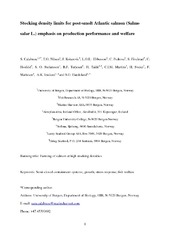| dc.contributor.author | Calabrese, Sara | |
| dc.contributor.author | Nilsen, Tom Ole | |
| dc.contributor.author | Kolarevic, Jelena | |
| dc.contributor.author | Ebbesson, Lars O.E. | |
| dc.contributor.author | Pinto Pedrosa, Cindy | |
| dc.contributor.author | Fivelstad, Sveinung | |
| dc.contributor.author | Hosfeld, Anne-Camilla Diesen | |
| dc.contributor.author | Stefansson, Sigurd Olav | |
| dc.contributor.author | Terjesen, Bendik Fyhn | |
| dc.contributor.author | Takle, Harald Rune | |
| dc.contributor.author | Martins, Catarina I.M. | |
| dc.contributor.author | Sveier, Harald | |
| dc.contributor.author | Mathisen, Frode | |
| dc.contributor.author | Imsland, Albert Kjartanson | |
| dc.contributor.author | Handeland, Sigurd Olav | |
| dc.date.accessioned | 2018-04-11T13:19:24Z | |
| dc.date.available | 2018-04-11T13:19:24Z | |
| dc.date.issued | 2017-02 | |
| dc.Published | Calabrese S, Nilsen TO, Kolarevic J, Ebbesson L, Pinto Pedrosa C, Fivelstad S, Hosfeld CD, Stefansson SO, Terjesen Bf, Takle HR, Martins CI, Sveier H, Mathisen F, Imsland A, Handeland SO. Stocking density limits for post-smolt Atlantic salmon (Salmo salar L.) emphasis on production performance and welfare. Aquaculture. 2017;468, Part 1:363-370 | eng |
| dc.identifier.issn | 1873-5622 | en_US |
| dc.identifier.issn | 0044-8486 | en_US |
| dc.identifier.uri | https://hdl.handle.net/1956/17606 | |
| dc.description.abstract | For the development of commercial scale semi-closed sea systems for farming post-smolt Atlantic salmon (Salmo salar), further knowledge is required on the interaction between fish density, farming conditions and fish welfare. In this experiment post-smolts (115.0 g ± 13.6) were stocked at 5 different densities (25, 50, 75, 100 and 125 kg m− 3), and kept at these densities for 8 weeks. All treatments received an equal specific flow rate of 0.6 L kg fish− 1 min− 1 of flow-through seawater (fully oxygenated, salinity 34‰ and temp. 9.3 °C) and water oxygen (O2), pH, carbon dioxide (CO2) and total ammonia nitrogen (TAN) levels were monitored in the outlet and kept within recommended limits. Over the 8 week period, specific growth rate (SGR %) was significantly reduced in stocking densities of 50 kg m− 3 and above. Increasing density from 100 kg m− 3 to 125 kg m− 3 lead to a 42% decrease in SGR. Between 50 kg m− 3 and 125 kg m− 3 there was a correlation between reduced feed intake and increased stocking density and there was a linear increase in feed conversion ratio (FCR) with stocking density (25 kg m− 3 to 125 kg m− 3). At the end of the 8 week period primary and secondary stress responses such as elevated plasma levels of cortisol, sodium, pCO2 and decreased plasma pH were observed in the highest density treatment compared to other treatments. In combination with the reduced SGR in the highest density treatments these results indicate an allostatic overload i.e. the environment has exceeded the adaptive ability of the fish with chronic adverse effects on fish welfare. Stocking densities of 100 kg m− 3 or more also increased pelvic fin damage and the prevalence of cataracts was higher in the 125 kg m− 3 treatment. In conclusion, our results suggest that at this temperature and fish size it is feasible to rear Atlantic salmon post-smolts in densities up to 75 kg m− 3 without compromising performance and welfare. | en_US |
| dc.language.iso | eng | eng |
| dc.publisher | Elsevier | en_US |
| dc.rights | Attribution CC BY-NC-ND | eng |
| dc.rights.uri | http://creativecommons.org/licenses/by-nc-nd/4.0/ | eng |
| dc.subject | Semi-closed containment systems | eng |
| dc.subject | Growth | eng |
| dc.subject | Stress response | eng |
| dc.subject | Fish welfare | eng |
| dc.title | Stocking density limits for post-smolt Atlantic salmon (Salmo salar L.) emphasis on production performance and welfare | en_US |
| dc.type | Peer reviewed | |
| dc.type | Journal article | |
| dc.date.updated | 2018-01-25T12:38:42Z | |
| dc.description.version | acceptedVersion | en_US |
| dc.rights.holder | Copyright 2016 Elsevier B.V. | en_US |
| dc.identifier.doi | https://doi.org/10.1016/j.aquaculture.2016.10.041 | |
| dc.identifier.cristin | 1396679 | |
| dc.source.journal | Aquaculture | |
| dc.relation.project | Fiskeri- og havbruksnæringens forskningsfond: 900816 | |
| dc.relation.project | Norges forskningsråd: 217502 | |

